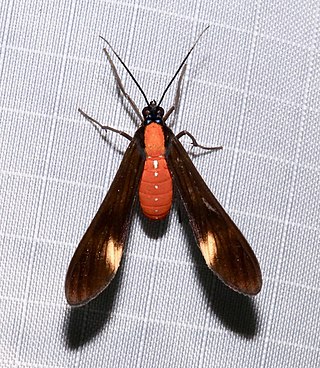
The black bittern is a bittern of Old World origin, breeding in tropical Asia from Pakistan, India, Bangladesh and Sri Lanka east to China, Indonesia, and Australia. It is mainly resident, but some northern birds migrate short distances.

The yellow-necked mouse, also called yellow-necked field mouse, yellow-necked wood mouse, and South China field mouse, is closely related to the wood mouse, with which it was long confused. It was only recognised as a separate species in 1894. It differs in its band of yellow fur around the neck and in having slightly larger ears and usually being slightly larger overall. Around 100 mm in length, it can climb trees and sometimes overwinters in houses. It is found mostly in mountainous areas of southern Europe, but extends north into parts of Scandinavia and Britain. It facilitates the spread of tick-borne encephalitis to humans and is a reservoir species for the Dobrava virus, a hantavirus that is responsible for causing haemorrhagic fever with renal syndrome.

The yellow-throated leaflove is a species of leaflove in the bulbul family of passerine birds. It is the only species of the monotypic genus Atimastillas. The yellow-throated leaflove is found in western and central Africa. Its natural habitats are subtropical or tropical dry forests, moist savanna, and subtropical or tropical moist shrubland.

The yellow-backed tanager is a species of bird in the family Thraupidae, the tanagers.

The yellow-throated honeyeater is a species of passerine bird in the honeyeater family Meliphagidae. It is similar in behaviour and appearance to the white-eared honeyeater and is endemic to Australia's island state of Tasmania. It was formerly considered a pest of orchards.

The Abyssinian longclaw is a species of bird in the family Motacillidae.

The whiskered yuhina is a bird species in the white-eye family Zosteropidae. Its range extends across the Himalayan forests in northern India to northeast Indian states, Nepal, Bhutan, Bangladesh and in the east to Indochina including Laos, Myanmar, Thailand, and Vietnam. Its natural habitat is subtropical or tropical moist montane forests. The whiskered yuhina is sometimes found in mixed hunting parties with other yuhina and fulvetta species, but it has also been reported to not associate with mixed hunting parties in some areas. It is described as one of the commonest yuhinas in the Himalayas, although it is relatively uncommon to rare at low elevations. It prefers relatively undisturbed closed canopy cover. It is one among several other birds hunted by livestock herders in Northeast India.

Rhynchopyga is a genus of moths in the subfamily Arctiinae.
Rhynchopyga albigutta is a species of moth in the subfamily Arctiinae. It is found in Peru.
Rhynchopyga castra is a species of moth in the subfamily Arctiinae. It was described by E. Dukinfield Jones in 1912. It is found in Brazil.
Rhynchopyga garleppi is a species of moth in the subfamily Arctiinae. It is found in Bolivia.
Rhynchopyga hymenopteridia is a species of moth in the subfamily Arctiinae. It is found in Bolivia.
Rhynchopyga ichneumonea is a species of moth in the subfamily Arctiinae. It is found in Colombia.
Rhynchopyga pimpla is a species of moth in the subfamily Arctiinae. It is found in Peru.
Rhynchopyga semibrunnea is a species of moth in the subfamily Arctiinae. It is found in Bolivia.
Rhynchopyga semirufa is a species of moth in the subfamily Arctiinae. It is found in Peru.
Rhynchopyga steniptera is a species of moth in the subfamily Arctiinae. It is found in Guyana.
Rhynchopyga subflamma is a species of moth in the subfamily Arctiinae. It is found in Panama.

The Euchromiina are a subtribe of tiger moths in the family Erebidae. It was described by Arthur Gardiner Butler in 1876. Many species in the subtribe are mimics of wasps. Euchromiina have always been considered closely related to the subtribe Ctenuchina due to their similarity to moths and wasps. These two subtribes make up around 3,000 valid species, the majority of which occur in the Neotropics.
Trigonoptera flavicollis is a species of beetle in the family Cerambycidae. It was described by Stephan von Breuning in 1940.









